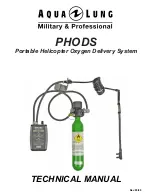
CS616 and CS625 Water Content Reflectometers
7.4.2 Soil Organic Matter, Clay Content and Soil Bulk Density
The amount of organic matter and clay in a soil can alter the response of
dielectric-dependent methods to changes in water content. This is apparent
when mechanistic models are used to describe this measurement methodology.
The electromagnetic energy introduced by the probe acts to re-orientate or
polarize the water molecules. If other forces are acting on the polar water
molecules, the force exerted by the applied signal will be less likely to polarize
the molecules. This has the net effect of ‘hiding’ some of the water from the
probe. Additionally, some clays sorb water interstitially and thus inhibit
polarization by the applied field.
Organic matter and some clays are highly polar. These solid constituents can
affect CS616/CS625 response to water content change and require specific
calibration. This affect is opposite to that of the ‘hiding’ effect. It would be
convenient if the calibration of water content to CS616/CS625 output period
could be adjusted according to some parameter of the soil which reflects the
character of the signal attenuation. However, such a parameter has not been
identified.
The response of the water content reflectometer to changing water content has
been shown to change for some soils when bulk density exceeds 1.5 g cm
-3
.
The response to changing water content is still well behaved, but the slope will
decrease with increasing bulk density.
7.5 Error Sources in Water Content Reflectometer
Measurement
7.5.1 Probe-to-Probe Variability Error
All manufactured CS616s/CS625s are checked in standard media. The limits
for probe response in the standard media ensure accuracy of
±
2% volumetric
water content.
7.5.2 Insertion Error
The method used for probe insertion can affect the accuracy of the
measurement. The probe rods should be kept as close to parallel as possible
when inserted to maintain the design wave guide geometry. The sensitivity of
this measurement is greater in the regions closest to the rod surface than at
distances away from the surface. Probes inserted in a manner that generates air
voids around the rods will indicate lower water content than actual. In some
applications, installation can be improved by using insertion guides or a pilot
tool. Campbell Scientific offers the CS650G insertion tool.
7.5.3 Signal Attenuation Error
Section 7.1,
Description of Measurement Method
, presents a detailed
description of CS616/CS625 operation. In summary, the CS616/CS625 is
primarily sensitive to the dielectric permittivity of the material surrounding the
probe rods. The propagation of electromagnetic energy along the probe rods
depends on the dielectric properties of the medium. When the reflection of the
applied signal from the end of the rods is detected by the CS616/CS625 circuit,
32
Summary of Contents for CS616
Page 2: ......
Page 8: ...Table of Contents iv ...
Page 50: ...CS616 and CS625 Water Content Reflectometers 42 ...
Page 52: ...Appendix A Discussion of Soil Water Content A 2 ...
Page 53: ......















































